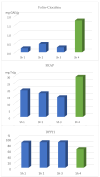Polyphenol Profile and Biological Activity of the Extracts from Sideritis scardica Griseb. (Lamiaceae) Herb
- PMID: 40872513
- PMCID: PMC12389434
- DOI: 10.3390/ph18081121
Polyphenol Profile and Biological Activity of the Extracts from Sideritis scardica Griseb. (Lamiaceae) Herb
Abstract
Background/Objectives: The beneficial and multifaceted effects of Sideritis scardica Griseb. extracts are attributed to the presence of polyphenolic compounds, particularly phenolic acids. Methods: The research was carried out for S. scardica herb of different origins (Albania, Bulgaria, North Macedonia, and Türkiye). Identification of compounds was performed using the HPLC/ESI-QTOF-MS method; phenolic acids and flavonoids were determined spectrophotometrically. The antioxidant activity of methanol extracts from studied herbs was determined using the Folin-Ciocalteu, DPPH, and FRAP methods, and the antimicrobial activity was evaluated using the broth microdilution method in accordance with the guidelines of the European Committee on Antimicrobial Susceptibility Testing (EUCAST). Results: We demonstrated the presence 18-20 active compounds, depending on the origin of the raw material, with verbascoside being the predominant compound in all samples. The raw material was characterized by significant polyphenol content and high antioxidant activity. DPPH tests revealed the highest antioxidant activity, ranging from 86.5% to 87.9%, in samples from Bulgaria, North Macedonia, and Türkiye, and the latter showed the strongest antimicrobial activity, particularly against Gram-positive pathogens and Candida spp. Conclusions: This research is the first report comparing the chemical composition and biological activity of S. scardica raw material of different origins. Our findings indicate that S. scardica herb extracts have significant phytotherapeutic potential, although this varies depending on the origin of the raw material, and point to the need for further research on this plant material, particularly in terms of the level of active compounds and their possible synergistic effects with conventional drugs, as well as the need for standardization.
Keywords: antimicrobial activity; antioxidant activity; herbal extracts; variability of chemical composition.
Conflict of interest statement
The authors declare no conflicts of interest.
Figures






Similar articles
-
Prescription of Controlled Substances: Benefits and Risks.2025 Jul 6. In: StatPearls [Internet]. Treasure Island (FL): StatPearls Publishing; 2025 Jan–. 2025 Jul 6. In: StatPearls [Internet]. Treasure Island (FL): StatPearls Publishing; 2025 Jan–. PMID: 30726003 Free Books & Documents.
-
Systemic pharmacological treatments for chronic plaque psoriasis: a network meta-analysis.Cochrane Database Syst Rev. 2020 Jan 9;1(1):CD011535. doi: 10.1002/14651858.CD011535.pub3. Cochrane Database Syst Rev. 2020. Update in: Cochrane Database Syst Rev. 2021 Apr 19;4:CD011535. doi: 10.1002/14651858.CD011535.pub4. PMID: 31917873 Free PMC article. Updated.
-
Systemic pharmacological treatments for chronic plaque psoriasis: a network meta-analysis.Cochrane Database Syst Rev. 2017 Dec 22;12(12):CD011535. doi: 10.1002/14651858.CD011535.pub2. Cochrane Database Syst Rev. 2017. Update in: Cochrane Database Syst Rev. 2020 Jan 9;1:CD011535. doi: 10.1002/14651858.CD011535.pub3. PMID: 29271481 Free PMC article. Updated.
-
Systemic pharmacological treatments for chronic plaque psoriasis: a network meta-analysis.Cochrane Database Syst Rev. 2021 Apr 19;4(4):CD011535. doi: 10.1002/14651858.CD011535.pub4. Cochrane Database Syst Rev. 2021. Update in: Cochrane Database Syst Rev. 2022 May 23;5:CD011535. doi: 10.1002/14651858.CD011535.pub5. PMID: 33871055 Free PMC article. Updated.
-
Properties of Plant Extracts from Adriatic Maritime Zone for Innovative Food and Packaging Applications: Insights into Bioactive Profiles, Protective Effects, Antioxidant Potentials and Antimicrobial Activity.Antioxidants (Basel). 2025 Jul 24;14(8):906. doi: 10.3390/antiox14080906. Antioxidants (Basel). 2025. PMID: 40867805 Free PMC article.
References
-
- Abeshi A., Precone V., Beccari T., Dundar M., Falsini B., Bertelli M. Pharmacologically active fractions of Sideritis spp. and their use in inherited eye diseases. Eurobiotech J. 2017;1:6–10. doi: 10.24190/ISSN2564-615X/2017/S1.02. - DOI
-
- Solomou A.D., Skoufogianni E., Mylonas C., Germani R., Danalatos N.G. Cultivation and utilization of “Greek mountain tea”(Sideritis spp.): Current knowledge and future challenges. Asian J. Agric. Biol. 2019;7:289–299.
-
- Papaporfyriou P.K., Sarrou E., Avramidou E., Abraham E.M. Abundance and phenotypic diversity of the medicinal Sideritis scardica Griseb. In relation to floristic composition of its habitat in northern Greece. Sustainability. 2020;12:2542. doi: 10.3390/su12062542. - DOI
-
- Behrendt I., Schneider I., Schuchardt J.P., Norman B., Andreas H. Effect of an herbal extract of Sideritis scardica and B-vitamins on cognitive performance under stress: A pilot study. Int. J. Phytomedicine. 2016;8:95–103.
LinkOut - more resources
Full Text Sources
Miscellaneous

